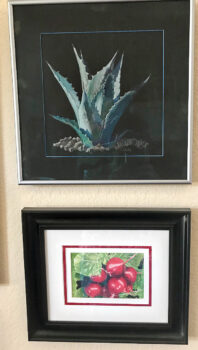
Paintings by Sandy Kautz (top) and Marsha Lyons
Marsha Lyons
This summer, June through September, there will be a display in the Creative Arts Center featuring 12 artists who work with colored pencils. Most people, when they think of colored pencils, think of the hard, pale colored pencils of childhood, the ones used in school to color cell diagrams in science classes and color maps. Colored pencils have come a long way. It is the proportion of pigment, which is fairly expensive, versus filler material that separates artist grade from student grade colored pencils. Today, colored pencils vary in hardness, depending upon the brand; yes, there are many brands, and some are rich and buttery feeling and wonderful to work with. One of the popular brands is Prismacolor Premier Colored Pencils, which carries 150 different pencils. As a colored pencil artist, we want to have them all.
Webster defines painting as “to produce in lines and colors on a surface by applying pigments.” Most colored pencil artists refer to their work as a painting because of the application of color washes, as well as the color layers that are applied. These washes are not wet, as with conventional forms of paint like oil or watercolor, but are used in much the same way.
The traditional way to use colored pencils is to use a light touch and put down many layers using either a linear, crosshatch, or scumbling (small overlapping circles) procedure. Some may put down as many as 12 to 20 layers, using a minimum of three different colors. When working with colored pencil, you use many different colors or shades for one color. If something is black, you don’t use just the black pencil. To achieve a rich black, you use many layers of Indigo Blue, Peacock Green, and Tuscan Red, and in the last couple of layers, you add Black. The same is true for red, green, etc. The different colors give it life and make the color very rich. On the other hand, you can make any color with just three pencils: Magenta, Canary Yellow, and True Blue. If you have noticed, I refer to the pencils by their specific name. This is the main way of identifying the pencils. This method is slow but very enjoyable for the person who likes detail, and it lends itself to a realistic style of painting.
The method of using 10 or more layers in a painting can be very slow and take months to do one painting. A newer method has been developed by some talented artists of applying the layers much more heavily and rapidly and using only five or six layers. Some paintings can be completed much more quickly using this method.
Colored pencils can also be used with other mediums. In the display, there will be a couple of paintings that are mixed medium.
Be sure and stop by to see the display.
